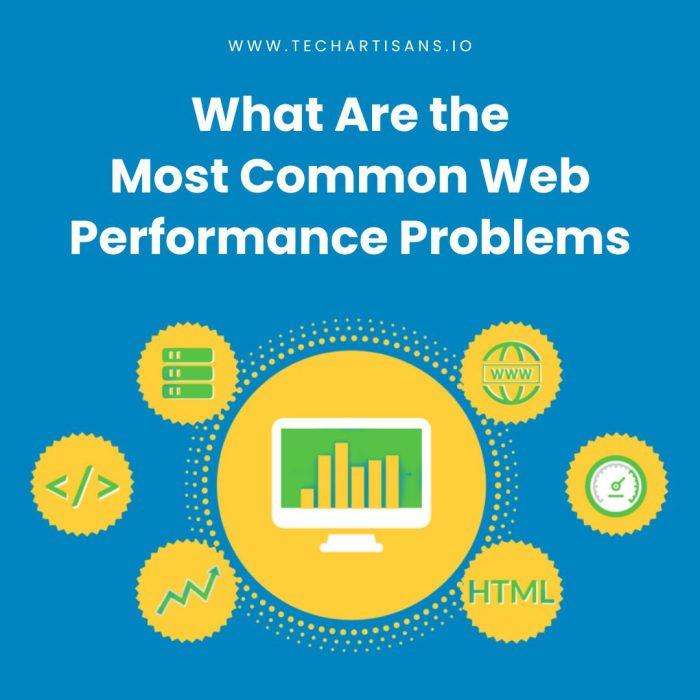Web performance is vital for user satisfaction and business success. Slow-loading websites deter visitors and reduce engagement. Addressing performance issues is essential for a smooth user experience and retaining customers. Staying informed about web performance is crucial for optimal digital presence. In this blog, we’ll explore the most common web performance problems and solutions to improve your website’s speed.
What Are the Most Common Web Performance Problems
When it comes to website performance, several problems can obstruct your website’s functionality and user experience. From slow loading times to unoptimized images. Before we discuss some of the most common web performance issues that could be holding your online business back, let’s understand what web performance is and why it is crucial.
Understanding Web Performance
Web Performance is like the heartbeat of your website. It’s how fast it loads and how smoothly it works. This can make or break your user’s experience. Let’s explore Website efficiency and see how it can set your business apart in the digital world.
Why is Web Performance Crucial for Your Business?
Website efficiency is crucial for your business’s success. A fast, smooth site keeps visitors engaged, leading to more interactions and higher sales. Search engines like Google also favor fast-loading sites, improving your search rankings. Plus, having a faster website can give you an edge over competitors in the digital race.
Database Design and Optimization
Smart database design and optimization are like having a tidy and organized storage room for your website’s data. This ensures quick access to information, making your site load faster and run smoother. Learn the basics of database-related performance issues.
Database-Related Performance Issues
Database-related performance issues often stem from unoptimized queries, insufficient indexing, or poor database design. These issues can result in slow data retrieval, leading to laggy site performance. Correcting these problems through smart database design and optimization can significantly improve your website’s performance and user experience.
Tips for avoiding poor database design
To avoid poor database design, ensure that you plan the schema carefully, considering future data requirements and growth. Implement indexing judiciously to speed up data retrieval. Regularly monitor your database performance and tune it as necessary for optimal performance. Lastly, consider using a database management system (DBMS) that aligns with your specific needs.
Network Latency and Bandwidth
Network latency and bandwidth significantly influence your website’s performance. While latency refers to the time it takes for data to travel from one point to another, bandwidth is the volume of data that can be transmitted over a specific period. Balancing these two factors is imperative for optimal web performance.
Impact of Network Issues On Web Performance
Network issues, including high latency or limited bandwidth, can severely hamper web performance. They can result in slow page load times and jerky media playback, leading to a frustrating user experience. Therefore, understanding and mitigating network issues is crucial for maintaining optimal website performance.
Strategies to Reduce Latency and Manage Bandwidth
To reduce latency, consider implementing content delivery networks (CDNs) that store cached versions of your website in various geographical locations to speed up data transmission. Manage bandwidth by optimizing your website’s elements, including compressing images and using efficient coding techniques. Regularly monitor and adjust as necessary to maintain optimal performance.
Memory Leaks and Resource Constraints
Memory leaks and resource constraints are common performance problems that can significantly slow down your website. They occur when a website uses more resources than necessary or fails to release unused resources. Let’s examine these issues more closely and discuss potential solutions.
Understanding Memory Leaks and Their Effects
Memory leaks can hurt your website’s performance, causing slow load times and crashes. They also impact server performance. Detecting leaks is essential, and tools like Google Chrome’s DevTools help. From a business perspective, memory leaks can drive visitors away, so fixing them is crucial for optimal performance and user satisfaction.
Best Practices for Resource Management
Efficient resource allocation is vital for website performance. This includes techniques like lazy loading and regular monitoring. Caching and proper garbage collection are essential to save resources and prevent memory leaks, ensuring optimal performance.
Inefficient Code and Algorithms
Inefficient code and flawed algorithms can significantly impede your website’s performance, leading to slow page load times and a less-than-optimal user experience. Let’s delve into these common web performance issues and explore ways to address them.
Cost of Inefficient Code on Performance
Inefficient code can slow down your website, increasing page load times and harming the user experience. It also strains your servers, raises hosting costs, and affects SEO rankings due to slower load times.
How to Optimize Algorithms and Code
Select the right algorithm, refactor code for efficiency, use effective data structures, profile and benchmark your code, and employ minification and compression techniques for faster website performance.
Caching Strategies
Caching is a vital solution for faster websites, reducing load times, and improving user experience. Let’s explore caching strategies for optimal web performance.
Role of Caching in Web Performance
Caching stores data for quick access, resulting in faster page load times and better user experiences. It reduces server load, enhances user engagement, and can positively impact SEO rankings by improving website performance.
Effective Caching Techniques
Saving data in a smart way makes websites faster. Techniques like browser and CDN caching store website data to speed up how quickly it shows. Database and object caching help the server, and HTTP caching lets you manage settings for a quicker website. This makes the internet faster and websites easier to use.
Server Overload and Scalability
Server overload and scalability are significant aspects of web performance. These factors play a pivotal role in maintaining a smooth and fast user experience, particularly during periods of high traffic. Understanding how to manage server load and effectively scale your website can be instrumental in mitigating common web performance problems.
Challenges of Server Overload and Scalability Issues
Following are the challenges of server overload and scalability that can cause website downtime and slow performance.
Burden of Increased Traffic
One of the primary challenges faced by servers is the sudden surge in traffic. Websites not designed to handle large volumes of simultaneous users can become overwhelmed, leading to sluggish load times and potentially, server crashes. This can severely hamper the user experience and lead to the loss of potential customers.
Memory and Storage Constraints
Memory and storage constraints can also be a big challenge. As a website grows, so too does its data. If the server’s storage capacity is not consistently upgraded to match this growth, it can result in slow response times and even data loss.
Server Scalability Issues
A major hurdle is server scalability. If a server is not scalable, it cannot accommodate an increase in load by modifying its capacity. The inability to scale effectively during peak traffic times can result in the website becoming inaccessible, causing a significant impact on user experience and potentially, loss of business.
Downtime and Service Interruptions
Lastly, server overload can lead to downtime and service interruptions. These periods of inactivity not only frustrate users but can also impact search engine rankings, leading to decreased visibility and lost revenue.
Solutions for Improving Scalability
Enhancing server scalability involves strategies and techniques to ensure consistent website performance during peak traffic times.
Implementing Load Balancing
Load balancing is a method that distributes network traffic across several servers to ensure no single server becomes overwhelmed. This technique can significantly improve response time and overall system throughput, allowing your website to handle increased traffic with ease.
Opting for Scalable Hosting
Choosing a scalable hosting solution allows you to increase or decrease server resources as per your website’s needs. This flexibility can help ensure your website remains accessible and responsive during peak traffic times.
Using Cloud Services
Cloud services provide scalable resources on demand. They allow for quick adjustments in your server resources to accommodate traffic surges, effectively addressing the scalability issue.
Deploying CDN
A Content Delivery Network (CDN) can also assist in managing high traffic. CDN stores cached versions of your site on a global network of servers, each delivering web content to users based on their geographical proximity, reducing server load and enhancing website performance.
Configuration and Maintenance
Entering the realm of Configuration and Maintenance, it’s critical to understand that the continual tuning and upkeep of your website are as vital as its development. These activities ensure your website’s optimal functionality and performance, paving the way for an enhanced user experience and better search engine rankings.
Importance of Correct Configuration Settings
Proper configuration settings are vital for a smooth website. Ensure servers and your CMS are configured correctly to handle traffic efficiently. Regular monitoring and adjustments maintain a great user experience and SEO ranking.
Maintaining Performance Through Regular Updates
Regular updates are a crucial element in maintaining optimal web performance. Ensuring that your server software, CMS, and all related plugins are up-to-date can notably enhance your site’s speed, security, and functionality. Each update often includes patches for performance issues identified in previous versions, resulting in a more streamlined and efficient platform for your website.
External System Integration
Integrating external systems is a critical aspect of web performance optimization. This process involves connecting your website with external tools and platforms to enhance functionality, streamline operations, and improve overall user experience.
How External Integrations Can Affect Performance
External integrations can impact web performance significantly. When done right, they enhance functionality, like CRM tools for automation or analytics for insights. However, poorly implemented integrations can slow down your site or cause issues. Plan and monitor integrations carefully for optimal performance.
Tips for Smooth System Integration
When integrating external systems, ensure compatibility and perform thorough testing. Regularly update and maintain integrations to avoid performance issues. APIs make integration smoother and more efficient. A well-implemented API can enhance functionality without affecting speed and stability.
Concurrency and Synchronization
As we venture deeper into the realm of web performance optimization, it’s essential to discuss the role of concurrency and synchronization. These twin processes govern how tasks are executed simultaneously on your website, ensuring smooth interactions and optimal performance.
Concurrency Issues and Their Impact On Performance
Concurrency issues can harm web performance and user experience. They occur when multiple processes access shared data at once, leading to inconsistent outcomes. Ineffective handling can result in slow load times, data loss, and visitor dissatisfaction. Effective concurrency management is vital for a smooth and reliable web experience.
Techniques to Handle Synchronization Effectively
Effective synchronization techniques include locking, which restricts resource access, semaphores to control concurrent access, and optimistic synchronization in low-conflict settings. Implementing these methods enhances web performance by ensuring efficient and conflict-free interactions.
Monitoring and Logging
Monitoring and logging serve as critical components in identifying and resolving common web performance problems. They provide valuable insights into your website’s operations, revealing potential issues and enabling timely interventions to enhance overall performance. Let’s explore how these tools can contribute to more efficient and effective web performance management.
Necessity of Monitoring for Performance Management
Monitoring is an indispensable aspect of performance management for any website. It provides real-time data about the functioning of the website, detecting any anomalies, bottlenecks, or failures that may occur. By regularly monitoring your website, you can identify and resolve potential issues before they escalate, maintaining optimal site performance and ensuring a seamless user experience.
Implementing Effective Logging Practices
Logs record events, errors, and transactions, aiding in issue identification and troubleshooting. To optimize performance, log only essential information to prevent resource drain. Regularly review and manage logs, using log management tools for better insights.
Conclusion
Addressing the most common web performance problems such as website speed issues not only enhances user experience but also bolsters your SEO rankings. It’s crucial to adopt a proactive approach to performance optimization, actively identifying and resolving potential issues before they impact your users. Regular monitoring, effective logging practices, and efficient handling of concurrency and synchronization are key tactics to ensure a fast, reliable, and engaging website.







